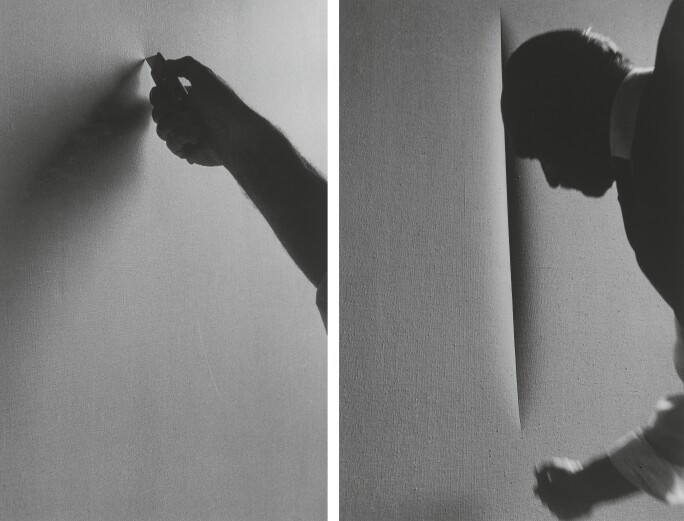“I do not want to make a painting; I want to open up space, create a new dimension, tie in the cosmos, as it endlessly expands beyond the confining plane of the picture.”

It is in the remarkable contrast between the white of the surface and the darkness of the void, exemplified in Concetto Spaziale, Attesta that Fontana’s Tagli series reach the height of their artistic expression; the aggressive vigor of the single cut appears in a pristine no-man's-land, unhinged from the conventions of time and space . Fontana explained that he chose white because it is the “purest, least complicated, most understandable color," that which most immediately struck the note of "pure simplicity," "pure philosophy," "spatial philosophy," and "cosmic philosophy" to which Fontana more than ever aspired during the last years of his life. (Enrico Crispolti, Lucio Fontana, Catalogue Raisonné des Peintures et Environments Spatiaux, Vol. I, Brussels 1974, p. 137) This is perhaps why Fontana chose to use only this combination of white ground and black slash in his installation for the XXXIII Venice Biennale in 1966, for which he won the Grand Prize for painting. Striking for its exceptional dynamism, highly desirable palette and impressive scale, Concetto Spaziale, Attesta epitomizes Lucio Fontana’s revolutionary practice.

Right: Jackson Pollock, The Deep, 1953 Musée National d’Art Moderne, Centre Georges Pompidou, Paris, France Image © CNAC/MNAM/Dist. RMN-Grand Palais / Art Resource, NY Art © 2018 Pollock-Krasner Foundation / Artists Rights Society (ARS), New York
Fueled by a desire to break free of the conventional limitations of the picture plane and engage in spatial transcendence, Lucio Fontana remains one of the most eminent innovators in the Contemporary sphere. Concetto Spaziale, Attesa is a superlative and large scale example of Fontana’s iconic Tagli series, itself an eloquent and timeless expression of the artist’s Spatialist project, which contended traditional distinctions of space and time and demarcated the possibilities of a fourth dimension. Indeed, Fontana’s liberation of the canvas from the constraints of two-dimensionality through his vertical slashes was as radical as Pollock’s dramatic handling of pigment ; a vigorous yet distinctly measured artistic expression that beautifully balanced spontaneity and control and dramatically ruptured the centuries-old paradigm of painting on canvas. Unlike Pollocks additive technique however, Fontana was decidedly more destructive, favoring an almost vandalistic approach of cutting and gouging his canvas.
"Now in space there is no longer any measurement. Now you see infinity in the Milky Way…. the sense of measurement and of time no longer exists…. And my art too is all based on this purity of the philosophy of nothing, which is not a destructive nothing but a creative nothing… And the slash, and the holes, the first holes, were not the destruction of the painting… it was a dimension beyond the painting, the freedom to conceive art through any means, through any form."

Fontana’s oeuvre was constantly informed by his abiding interest in outer space and new frontiers. By the 1960s, Fontana’s practice of breaking through the canvas and into a heretofore unexplored territory had gained newfound relevance alongside ground-breaking concurrent advances in space travel. The ‘Space Race’ had established the moon as the next frontier for human exploration and dominated the global political zeitgeist. Fontana was explicit with regard to his emulation of the cosmic explorations of his era, and confident in the implication that his actions had for the aesthetic realm: "The discovery of the Cosmos is that of a new dimension, it is the Infinite: thus I pierce this canvas, which is the basis of all arts and I have created an infinite dimension, an x which for me is the basis for all Contemporary Art." (Lucio Fontana quoted in: Exh. Cat., Venice, Peggy Guggenheim Collection (and travelling), Lucio Fontana: Venice/New York, 2006, p. 19) In Concetto Spaziale, Attesta the pristine surface of the work delivers an overwhelming visual experience of spectacular clarity that borders on the sublime, a perfect expression of Fontana’s search for "the Infinite”.

